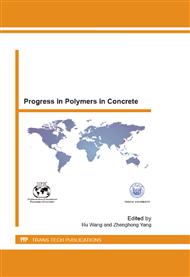[1]
D.W. Fowler, Polymers in concrete: a vision for the 21st century, Cement Concrete Comp. 21 5 (1999) 449-452.
DOI: 10.1016/s0958-9465(99)00032-3
Google Scholar
[2]
D. Van Gemert, L. Czarnecki, M. Maultzsch, H. Schorn, A. Beeldens, P. Łukowski, E. Knapen, Cement concrete and concrete–polymer composites: Two merging worlds: A report from 11th ICPIC Congress in Berlin, 2004, Cement Concrete Comp. 27 9 (2005) 926 - 933.
DOI: 10.1016/j.cemconcomp.2005.05.004
Google Scholar
[3]
V. Zivica, The properties of cement paste with admixture of polyvinyl acetate emulsion, Bulletin RILEM, 28 (1965) 121-128.
Google Scholar
[4]
J. Hosek, Properties of Cement Mortars Modified by Polymer Emulsion, ACI Journal Proceedings, 63 12 (1966) 1411-1424.
DOI: 10.14359/7674
Google Scholar
[5]
Z. Su, J.M. Bijen, J.A. Larbi, The influence of polymer modification on the adhesion of cement pastes to aggregates, Cement Concrete Res. 21 5 (1991) 727-736.
DOI: 10.1016/0008-8846(91)90167-g
Google Scholar
[6]
Y. Ohama, Handbook of polymer-modified concrete and mortars, Noyes Publications, Park Ridge, NJ (1995).
Google Scholar
[7]
J-H. Kim, R.E. Robertson, A.E. Naaman, Structure and properties of poly (vinyl alcohol)-modified mortar and concrete, Cement Concrete Res. 29 3 (1999) 407-415.
DOI: 10.1016/s0008-8846(98)00246-4
Google Scholar
[8]
J-H. Kim, R.E. Robertson, Effects of polyvinyl alcohol on aggregate-paste bond strength and the interfacial transition zone, Adv. Cem. Based Mater., 8 2 (1998) 66-76.
DOI: 10.1016/s1065-7355(98)00009-1
Google Scholar
[9]
E. Knapen, Microstructure formation in cement mortars modified with water soluble polymer, Ph.D. Thesis, Katholieke Universiteit, Bélgica (2007).
Google Scholar
[10]
E. Knapen, D. Van Gemert, Cement hydration and microstructure formation in the presence of water-soluble polymers, Cement Concrete Res. 39 1 (2009) 6-13.
DOI: 10.1016/j.cemconres.2008.10.003
Google Scholar
[11]
Y. Ohama, S. Kan, Effects of specimen size on strength and drying shrinkage of polymer modified concrete, Int. J. Cem. Compos. Lightweight Concr. 4 4 (1982) 229-233.
DOI: 10.1016/0262-5075(82)90026-4
Google Scholar
[12]
ACI 548.1R-09, ACI Committee. Guide for the Use of Polymers in Concrete, (2009).
Google Scholar
[13]
T.M. Pique, A. Vázquez, Cemento Pórtland modificado con polivinil alcohol y nano mortmorillonitas, 18º Technical Meeting and IV International Congress of the Argentinean Association of Concrete Technology (AATH) (2010).
Google Scholar
[14]
T.M. Pique, H.M. Balzamo, A. Vázquez, Evaluation of the hydration of Portland cement modified with polyvinyl alcohol and nano clay, Key Eng. Mat. 477 (2011) 47-56.
DOI: 10.4028/www.scientific.net/kem.466.47
Google Scholar
[15]
T.M. Pique, A. Vázquez, Control of polymer modified cement's hydration rate by the addition of organically modified montmorillonites, Cement Concrete Comp. (2012), available online.
DOI: 10.1016/j.cemconcomp.2012.12.006
Google Scholar
[16]
M. Romer, Comparative test - Part I - Comparative test of 'penetrability' methods, Mater. Struct., 38 10 (2005) 895-906.
DOI: 10.1007/bf02482256
Google Scholar
[17]
A.A.P. Mansur, D.B. Santos, H.S. Mansur, A microstructural approach to adherence mechanism of poly(vinyl alcohol) modified cement systems to ceramic tiles, Cement Concrete Res., 37 2 (2007) 270.
DOI: 10.1016/j.cemconres.2006.11.011
Google Scholar


